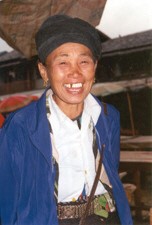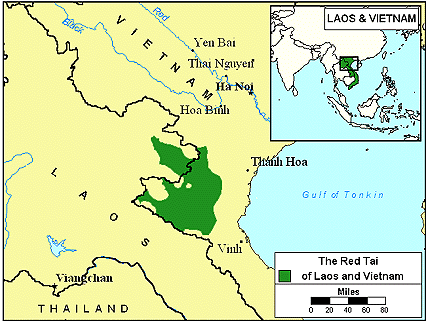Centuries ago, the Tai Daeng people lived in China. Relentless pressure by the Chinese gradually forced them southward. Eventually they settled in Laos, finding it difficult to find enough food.
Tai Daeng is a tonal language spoken by people who are often known as the Red Tai. The Red Tai name comes from the nearby Red River which winds through the high valleys of northeastern Laos near the border of northern Vietnam. They are members of a larger cultural, linguistic group of Tai peoples that includes the Laotians, the Shan and others. Today, most live in Vietnam, but some live over the border in Laos.
The Tai Daeng are extremely polite and hospitable. They brought their children up to respect those with higher rank. They highly respect age. Type of occupation, wealth, and place and type of residence follow age in terms of respect and rank. Farmers rank below artisans, merchants and city government officials; and clergy are a separate group.
Families are at the core of Tai Daeng society. In rural areas, the entire immediate family lives together. A young married couple may live with the wife's family until they can establish their own home. Although the father is the head of the family, Tai Daeng husbands and wives appear to have a harmonious relationship. In fact, an almost equal division of labor by sex distinguishes the Tai Daeng. Both men and women plow, fish, cook, tend to the babies, clean house, and wash clothes.
Most of the Tai Daeng work on small valley farms. Wet-rice, the major crop, supplies both a food staple and a cash crop. Many of the Tai Daeng work as blacksmiths. This is an important occupation, especially in villages along trade routes. The construction of improved roads has helped increase accessibility to the rural areas, which is opening new opportunities for the Tai Daeng. Improved highways also allow the government more effective control and make services more readily available to the rural dwellers.
The Tai Daeng live in small, self-governing villages that are usually contained in a single valley. Each village is under the control of the chao muong, or prince, to whom the common people pay taxes. Although the Tai Daeng are citizens of either Laos or Vietnam, they have very little power in the government.
Almost all the Tai Daeng combine folk animism (belief that non-living objects have spirits) with Buddhism. They worship various spirits and objects and also believe that people have multiple personal souls. They hold ceremonies for "recalling" the souls because they believe that this will strengthen the individual personality. The Tai Daeng believe in spirits of the dead, the natural world, the political world, various localities, etc.
Over one-third of Tai Daeng are Buddhists. They are followers of Buddha ("the enlightened one") and seek to eliminate suffering and improve their future by gaining merit in pursuit of perfect peace, or nirvana. They believe they can gain merit by feeding monks, donating to temples and attending worship services.
Each village has its own Buddhist temple or monastery. The young men usually attend the village monasteries for about three months to study Buddhism.
The Tai Daeng people need better medical care. They often die from preventable diseases, since medical professionals are nowhere nearby. To make matters worse, they then turn to malevolent spirits for cures.
Pray the hearts of the Tai Daeng people would be stirred to hunger after God.
Pray that family-based movement to Christ will soon transform Tai Daeng society, blessing them spiritually and economically.
Pray for the Lord to move in the hearts of believers to give up their own rights and sacrifice their lives to see the Tai Daeng people blessed by the work of Jesus Christ, the only Savior.
Pray for Tai Daeng decision makers to open their communities to Christ's ambassadors.
Scripture Prayers for the Tai Daeng in Laos.
| Profile Source: Joshua Project |












